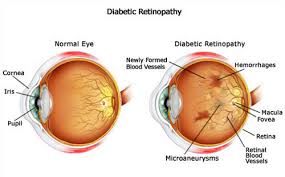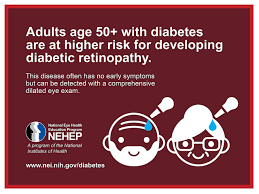According to the American Academy of Ophthalmology, approximately 29 million Americans age 20 or older have diabetes, but almost one-third don’t know they have the disease and are at risk for vision loss and other health problems.
Early symptoms are often unnoticed, therefore vision may not be affected until the disease is severe and less easily treated.
Diabetic eye disease, a group of eye problems that affects those with diabetes, includes diabetic retinopathy, cataracts and glaucoma. The most common of these is diabetic retinopathy especially those with Type I Diabetes Mellitus (DM), which affects 5.3 million Americans age 18 and older. When diagnosed with DM Type I as opposed to Type II the higher the odds you will develop eye problems especially if you are non-compliant in taking care of the diabetes. Why? Because in Type I Diabetes you develop this diabetes in childhood not adulthood like in Type II Diabetes and that patient with DM from childhood will be with high glucose longer than one who develops it later in life, regarding Type II (For example take Mary Tyler Moore who had Type I DM and did have severe vision loss to blindness almost with her vision later in life but with the disease from childhood. The longer you have the disease the higher you risk of having vision loss since your exposed to high blood glucose in your body versus another person with no diabetes or a patient who got DM later in life).
Diabetic retinopathy is a potentially blinding condition in which the blood vessels inside the retina become damaged from the high blood sugar levels associated with diabetes. This leads to fluids leaking into the retina and obstructing blood flow. Both may cause severe vision loss.
Once you are diagnosed with diabetes, schedule a complete dilated eye examination with your Eye M.D. (ophthalmologist) at least once a year. Make an appointment promptly if you experience blurred vision and/or floaters that:
-
- Affect only one eye;
- Last more than a few days;
- Are not associated with a change in blood sugar.
Diabetes can also affect your vision by causing cataracts and glaucoma. If you have diabetes, you may get cataracts at a younger age, and your chances of developing glaucoma are doubled.
Prevention of this vision loss is:
Early diagnosis of diabetes and, most importantly, maintaining STRICT CONTROL of blood sugar and hypertension through diet, exercise and medication, all these steps can help reduce your risk of developing eye disease associated with diabetes.

